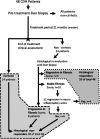Can Interferon Therapy Change the Natural Course of Hepatitis Delta Infection?: a Clinical and Pathological Study
- PMID: 34694876
- PMCID: PMC8765312
- DOI: 10.1128/AAC.01586-21
Can Interferon Therapy Change the Natural Course of Hepatitis Delta Infection?: a Clinical and Pathological Study
Abstract
Chronic delta hepatitis (CDH) has a worse outcome than other types of viral hepatitis. High-dose, long-term alpha interferon (IFN-α) is the approved treatment and may ameliorate the course of infection. We evaluated long-term histological outcomes of CDH patients treated with IFN-α. Patients with histologically proved noncirrhotic CDH who were treated with high-dose IFN-α for at least 1 year were classified as cirrhotic or noncirrhotic at the end of treatment. Noncirrhotic patients also had posttreatment liver biopsies. Patients were designated histologically responsive or nonresponsive on the basis of fibrosis status. Histological, virological, and biochemical courses were analyzed. Forty-eight patients were treated with IFN-α (conventional and/or pegylated) for a median of 24 months with a posttreatment follow-up of 5 years. During the follow-up, cirrhosis developed in 24 patients, 5 of whom were decompensated. There was no difference between pre- and posttreatment fibrosis scores for 24 noncirrhotic patients at the end of follow-up. Among patients, 13% (n = 6) had decreased, 21% (n = 10) had steady, and 16% (n = 8) had increased fibrosis scores. Persistent viral response (PVR) was achieved in 16 patients (33%). Twenty percent of the entire group was histologically responsive (decreasing or steady fibrosis scores with improved necroinflammatory scores), while nearly 80% had histological progression/cirrhosis. PVR was significantly associated with histological response. The long-term natural course of patients who were treated with high dose IFN-α for at least 1 year was evaluated clinically and histologically. Despite the association of PVR with histological response, IFN-α treatment did not change the natural course of CDH; clinical and histological progression continued in two-thirds of the cases despite treatment.
Keywords: cirrhosis; hepatitis delta; histology; interferon alpha; natural course.
Conflict of interest statement
We have no conflicts of interest to declare.
Figures



Similar articles
-
Two-year interferon therapy with or without ribavirin in chronic delta hepatitis.Antivir Ther. 2005;10(6):721-6. Antivir Ther. 2005. PMID: 16218171 Clinical Trial.
-
Efficacy of pegylated interferon-α treatment for 24 months in chronic delta hepatitis and predictors of response.Antivir Ther. 2013;18(4):561-6. doi: 10.3851/IMP2381. Epub 2012 Sep 14. Antivir Ther. 2013. PMID: 22976528
-
Lamivudine-high dose interferon combination therapy for chronic hepatitis B patients co-infected with the hepatitis D virus.J Viral Hepat. 2000 Nov;7(6):428-34. doi: 10.1046/j.1365-2893.2000.00254.x. J Viral Hepat. 2000. PMID: 11115054 Clinical Trial.
-
Management of chronic hepatitis B.Evid Rep Technol Assess (Full Rep). 2008 Oct;(174):1-671. Evid Rep Technol Assess (Full Rep). 2008. PMID: 19408969 Free PMC article. Review.
-
Treatment of chronic hepatitis B: case selection and duration of therapy.J Gastroenterol Hepatol. 2002 Apr;17(4):409-14. doi: 10.1046/j.1440-1746.2002.02767.x. J Gastroenterol Hepatol. 2002. PMID: 11982721 Review.
References
-
- Degertekin H, Yalcin K, Yakut M. 2006. The prevalence of hepatitis delta virus infection in acute and chronic liver diseases in Turkey: an analysis of clinical studies. Turk J Gastroenterol 17:25–34. - PubMed
-
- Fattovich G, Giustina G, Christensen E, Pantalena M, Zagni I, Realdi G, Schalm SW. 2000. Influence of hepatitis delta virus infection on morbidity and mortality in compensated cirrhosis type B. The European Concerted Action on Viral Hepatitis (Eurohep). Gut 46:420–426. doi:10.1136/gut.46.3.420. - DOI - PMC - PubMed
MeSH terms
Substances
LinkOut - more resources
Full Text Sources
Other Literature Sources
Medical
Research Materials

